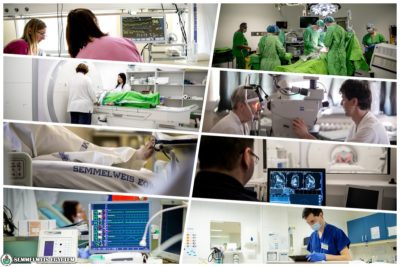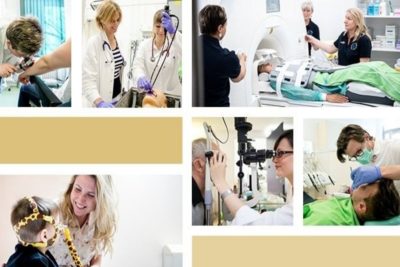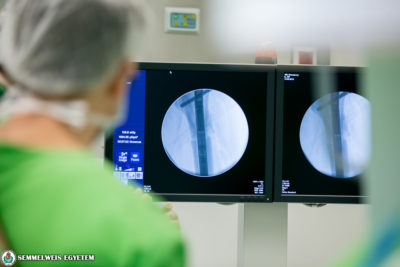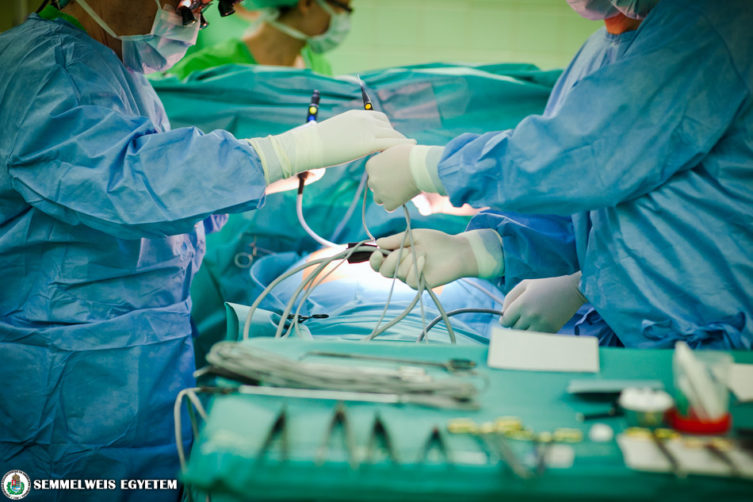 The Transplantation Medicine, Cardiac and Vascular Srugery session on the 2nd day of the Clinical Conference was opened by the lecture of Dr. Péter Gloviczki (Mayo Clinic), which gave detailed insight into the infrarenal aortic aneurysm practice at Mayo Clinic, emphasizing the need for aortic aneurysm screening especially among male smokers above the age of 65. Dr. István Hartyánszky (Heart and Vascular Centre, Department of Cardiology) spoke about adult heart transplantation in Hungary and the Centre’s artificial heart programme. In 2019 a record number of 63 adult heart transplantations were performed at the Centre, and a stable artificial heart programme is necessary for the successful treatment of heart failure. Dr. István Hartyánszky and Dr. János Fazakas (Department of Transplantation and Surgery) gave an account of the latest developments in liver transplantation, and presented the benefits of CYP enzyme-based monitoring and transfusion-free liver transplantation. Dr. Ferenc Rényi-Vámos (Semmelweis University’s Department of Thoracic Surgery based at the National Institute of Oncology) updated the participants on the status of lung transplantation in Hungary.
The Transplantation Medicine, Cardiac and Vascular Srugery session on the 2nd day of the Clinical Conference was opened by the lecture of Dr. Péter Gloviczki (Mayo Clinic), which gave detailed insight into the infrarenal aortic aneurysm practice at Mayo Clinic, emphasizing the need for aortic aneurysm screening especially among male smokers above the age of 65. Dr. István Hartyánszky (Heart and Vascular Centre, Department of Cardiology) spoke about adult heart transplantation in Hungary and the Centre’s artificial heart programme. In 2019 a record number of 63 adult heart transplantations were performed at the Centre, and a stable artificial heart programme is necessary for the successful treatment of heart failure. Dr. István Hartyánszky and Dr. János Fazakas (Department of Transplantation and Surgery) gave an account of the latest developments in liver transplantation, and presented the benefits of CYP enzyme-based monitoring and transfusion-free liver transplantation. Dr. Ferenc Rényi-Vámos (Semmelweis University’s Department of Thoracic Surgery based at the National Institute of Oncology) updated the participants on the status of lung transplantation in Hungary.
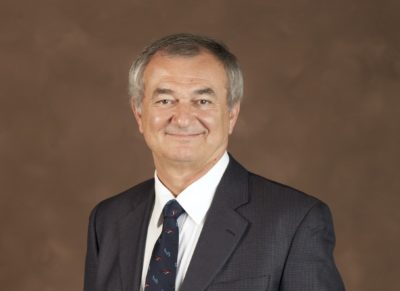
Dr. Péter Gloviczki, Chair Emeritus, Division of Vascular and Endovascular Surgery, Mayo Clinic; Editor-in-Chief, Journal of Vascular Surgery
What is your personal or professional relationship with Semmelweis University?
I graduated as a medical doctor from Semmelweis University in 1972. During my studies I worked at the 2nd Department of Pathology with Dr. Anna Kádár, later on I did my practical training at the Heart and Vascular Centre under leadership of Dr. Lajos Soltész, renowned vascular surgeon. I joined Mayo Clinic in 1987 but I have maintained my close relationship with Hungarian vascular surgeons and the university as well. It was a great honour to be awarded with the title Doctor Honoris Causa by Semmelweis University.
Your presentation was about the latest developments in the treatment of abdominal aneurysms. Why did you choose this topic and what is your main message?
The so-called abdominal aortic aneurysm (AAA) is the most common type of aneurysms: it occurs in 9% of people aged 65-85 and if the condition remains undetected by prior screening or examination, it usually leads to the rupture of the vessel wall. This has a very high mortality rate even if the patient is hospitalized promptly. Therefore, my main message is that it is very important to identify and treat AAA on time, before it leads to rupture.
What are the most promising developments in the field of vascular and endovascular interventions that may improve the patient’s prospects?
There have been considerable advances made in this field. It is now possible to repair large abdominal aortic aneurysms without abdominal surgery. Most of the AAA cases in the USA are restored with the help of a so-called stent graft that is introduced via catheter through the groin and is monitored by X-rays during the procedure. Patients have far fewer complications and they can often leave hospital the next day.
What is Hungarian-American cooperation like in this field?
We have a great relationship with Semmelweis University and the Hungarian community of vascular surgeons. We hold joint discussions with several university lecturers and many Hungarian doctors and surgeons spend time at Mayo Clinic for further training. Dr. Péter Banga, for example from the Department of Vascular and Endovascular Surgery spent a year at Mayo Clinic and learnt the latest methods of endovascular repair of AAA. I was also happy to present at Hungarian conferences on vascular surgery and at the invitation of Dr. Béla Merkely I have contributed to the writing of Dr. Péter Sótonyi’s textbook, The basics of vascular medicine.
The lectures in pulmonology were opened by Dr. Martina Vasakova (Thomayer Hospital), who spoke about the importance of multidisciplinary consultations in interstitial lung diseases and presented the diagnostic algorithm of chronic hypersensitive pneumonitis. In her lecture about asthma Dr. Lilla Tamási (Deapartment of Pulmonology) talked about the innovative results in the field of neutrophilic and eosinophilic asthma. Dr. Pál Maurovich-Horvat (Department of Medical Imaging) drew attention to the latest methodsof detecting microcalcification and the new paradigms of cardiovascular prevention guided by imaging. The last presentation of the session was held by Dr. Gianluca Pontone (Cardiovascular Imaging Department, University of Milan) primarily described the chest CT image specific of COVID-19 infected patients.
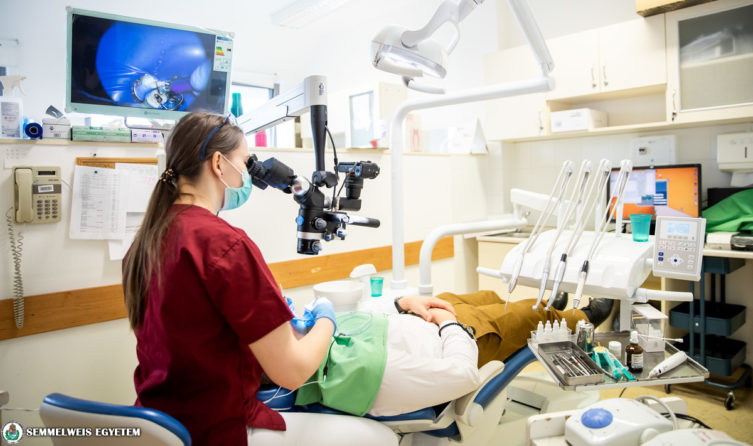 The dentistry session included leading Hungarian experts. Dr. István Urbán (Urbán Dental) presented the latest possibilities in vertical and horizontal bone augmentation. The presentation of Dr. Bálint Nemes (Department of Paedodontics and Orthodontics) focused on the complex care of children with cleft lip and palate, following the long process of the treatment. Dr. István Gera (Department of Periodontology) raised awareness of the link between oral and general health. Dr. Zsolt Németh (Department of Oro-Maxillofacial Surgery and Stomatology) gave an overview of the development of oral surgery and the latest trends in oral and maxillofacial surgery. Dr. Judit Borbély (Department of Prosthodontics) described the latest results in digital dentistry and how digital technology is replacing analogue technology. Dr. Péter Windisch (Department of Periodonitcs) spoke about the currently available reconstructive surgical technologies in periodontology. The presentation of Dr. Orsolya Németh (Department of Community Dentistry) on the problems in dental offices during COVID-19 was held by Dr. Mercédesz Orsós on behalf of the Department of Community Dentistry.
The dentistry session included leading Hungarian experts. Dr. István Urbán (Urbán Dental) presented the latest possibilities in vertical and horizontal bone augmentation. The presentation of Dr. Bálint Nemes (Department of Paedodontics and Orthodontics) focused on the complex care of children with cleft lip and palate, following the long process of the treatment. Dr. István Gera (Department of Periodontology) raised awareness of the link between oral and general health. Dr. Zsolt Németh (Department of Oro-Maxillofacial Surgery and Stomatology) gave an overview of the development of oral surgery and the latest trends in oral and maxillofacial surgery. Dr. Judit Borbély (Department of Prosthodontics) described the latest results in digital dentistry and how digital technology is replacing analogue technology. Dr. Péter Windisch (Department of Periodonitcs) spoke about the currently available reconstructive surgical technologies in periodontology. The presentation of Dr. Orsolya Németh (Department of Community Dentistry) on the problems in dental offices during COVID-19 was held by Dr. Mercédesz Orsós on behalf of the Department of Community Dentistry.
The first session on internal medicine offered a wide variety of lectures. The opening presentation was held by Dr. Uwe Heemann (Klinikum rechts der Isar Technical University) on cardiovascular risk assessment of long-term dialysis patients and the role of dialysis fluids. Dr. Tamás Masszi (Department of Internal Medicine and Haematology) gave a presentation on CAR T cell therapy in the treatment of B-cell lymphomas and leukaemia. Novel therapeutic opportunities of acute myeloid leukaemia were presented by Dr. Péter Farkas (Department of Internal Medicine and Haematology). He highlighted that combination therapy of modern chemotherapeutic agents, bone marrow transplantation, targeted molecular therapy and immunotherapy may open up new horizons in the treatment of the disease with poor prognosis. Dr. Péter Igaz (Department of Internal Medicine and Oncology) spoke about the possible role of miRNAs in the differential diagnostics of adrenal tumours. Dr. Kimberly C. Gilmour (Camelia Botnar Laboratories, Great Ormond Street Hospital for Children NHS Foundation Trust) held a lecture of the diagnostics of primary immunodeficiency. In the last presentation of the session Dr. Zoltán Prohászka (Department of Internal Medicine and Haematology) spoke about the results achieved since the beginning of complement diagnostics in Hungary. Semmelweis University has become one of the leading institutions in complement diagnostics in the region by using the latest diagnostic procedures.
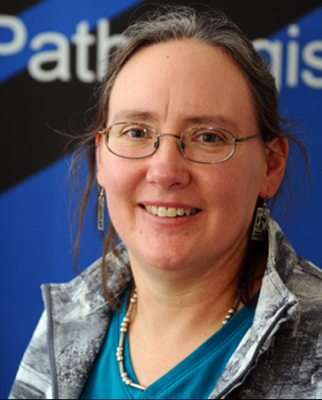
Dr. Kimberly C. Gilmour, Clinical Lead and Director of Cell Therapy, Camelia Botnar Laboratories, Great Ormond Street Hospital for Children NHS Foundation Trust
What is your personal or professional relationship with Semmelweis University?
I had the opportunity to have a young and talented researcher, Dr. Emese Molnár at Great Ormond Street Hospital (GOSH), who is a graduate of Semmelweis University and currently a PhD student. She and some of her colleagues at GOSH wrote a paper on a rare immunodeficiency (ALPS – autoimmune lymphoproliferative syndrome), which was published in in the prestigious journal Blood. I met the Ambassador and Scientific Attaché of Hungary to the United Kingdom, as well as the leaders of Semmelweis University through Dr. Emese Molnár. We are planning further cooperation with Semmelweis University the field of cell and gene therapy programme development.
Your presentation was about diagnostics of primary immunodeficiency. Why did you choose this topic and what is your main message?
Children and adults suffering from primary immunodeficiency (Primary Immunodeficiency – PID) are unable to fight infections, so they get sick very quickly and many of them die. Early diagnosis of such patients help them receive treatment on time, which will enable them to live healthy, productive lives. In the more severe cases, cell or gene therapies are used as well. It is very important to consider PID as the possible cause of a disease and take appropriate steps in order to start diagnostics.
What are the biggest challenges in the diagnostic of primary immunodeficiency?
A lot of people today still think that neonatal infections and neonatal death are common occurrence and most of these cases are not investigated. However, if recurring infections happen, it is worth asking for a professional diagnosis. The other big challenge is that PID involves more than 300 different genetic defects, which manifest in different ways, therefore it is difficult to develop screening tests that detect them all.
In the Pathology session the latest results of haematological diagnostics and therapy were discussed by Hungarian and international experts. The first lecture was held by Dr. Mikael Björnstedt (Clinical Pathology and Cytology, Karolinska University Hospital) on redox-modulation, which could open up new perspectives in the treatment of resistant tumours. Dr. Csaba Bödör (1st Department of Pathology and Experimental Cancer Research) explained the role of new generation sequencing. Oncogenic antigen receptor signalling pathways were discussed by Dr. Hendrik Veelken (Leiden University). Dr. Jan Zuna (Childhood Leukaemia Investigation Prague, CLIP) introduced the work of the institute in the research of the development, origin and biology of childhood leukaemia.
The third Surgery session was opened with the presentation of Dr. Shahrokh F. Shariat (Department of Urology, University of Vienna) on the beauty and challenges of clinical research, which targeted mainly young researchers and students. Dr. Zsolt Kopa (Department of Urology) spoke about the therapy of male infertility and the possibilities microsurgical interventions may open up in treating these conditions. Dr. Péter Nyirády (Department of Urology) gave an overview of the development in the diagnosis and therapy of primary and metastatic prostate cancers. The thirty-year history of implantable hearing aids and the latest technologies with special emphasis on personalized solutions were presented by Dr. Georg Mathias Sprinzl (Karl Landsteiner University of Health Sciences). The presentation of Dr. Zoltán Fent (Department of Otorhinolaryngology, Head- and Neck Surgery) on the increasing role of endoscopic procedures in the surgery of endonasal and endolarygeal diseases.
In the second Internal Medicine session, Dr. Juraj Payer (Comenius University) spoke about spoke about the importance of early treatment intervention of osteoporosis. Dr. István Takács (Department of Internal Medicine and Oncology) gave a presentation on the importance of vitamin D supplementation with a detailed presentation of literature data. Due to its role in maintaining a healthy the immune system, it is also essential during the COVID-19 pandemic. Dr. Mika Kivimäki (University College London) spoke about the results of large public health studies examining the effects of chronic stress and the socioeconomic environment on the incidence of diabetes. Dr. Péter Kempler (Deaprtment of Internal Medicine and Oncology) talked about the wide incidence of autonomic neuropathy and its cardiovascular effects. He highlighted the importance of screening diabetic patients, even in the absence of symptoms, and spoke about the dangers of tachycardia at rest as the only symptom.
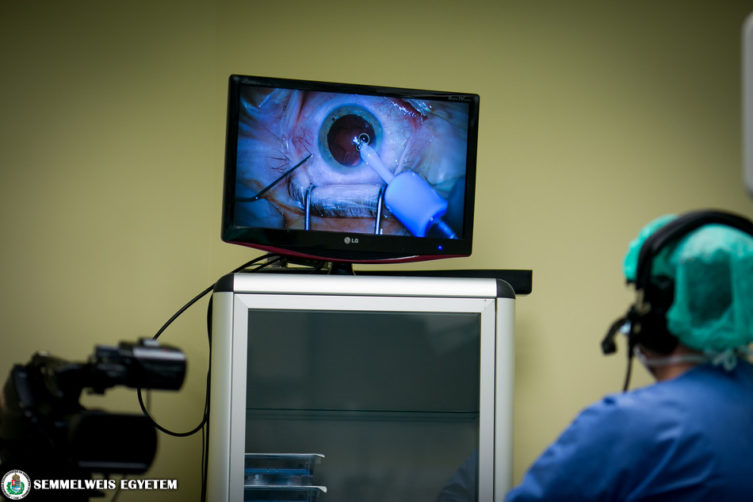 The first lecturer of the Dermatology and Ophthalmology session was Dr. Miklós Sárdy (Department of Dermatology and Venerology) talking about the manifestations of drug eruptions and their treatment. The presentation of Dr. Béla Tamási (Department of Dermatology and Venerology) was about the interdisciplinary management of syphilis, pointing out that the incidence of syphilis has increased by 25 percent over the past 10 years in Hungary. The presentation of Dr. Zoltán Zsolt Nagy (Department of Ophthalmology) gave an insight into the history of cataract surgery and modern methods, including femto laser-assisted cataract surgery that was first performed in 2008 at the university. The topic of the lecture of Dr. Miklós Resch (Department of Ophthalmology) was the current status and future of artificial vision and artificial intelligence. If the anatomical components of the retina and visual field are damaged, vision can be restored by artificial microelectronic devices. If vision can no longer be restored, vision can be simulated by electronically activating the visual pathway or cerebral cortex. Dr. Zsuzsanna Récsán (Department of Ophthalmology) spoke about diabetic eye diseases and emphasized early diagnosis, including the frequent ophthalmic follow-up examinations of diabetic patients. Dr. András Papp (Department of Ophthalmology) said that macular degeneration (AMD) in old age is the disease of the macula, which can lead to severe vision loss and even blindness. In addition to age, its main risk factors are smoking, diet, and genetic predisposition.
The first lecturer of the Dermatology and Ophthalmology session was Dr. Miklós Sárdy (Department of Dermatology and Venerology) talking about the manifestations of drug eruptions and their treatment. The presentation of Dr. Béla Tamási (Department of Dermatology and Venerology) was about the interdisciplinary management of syphilis, pointing out that the incidence of syphilis has increased by 25 percent over the past 10 years in Hungary. The presentation of Dr. Zoltán Zsolt Nagy (Department of Ophthalmology) gave an insight into the history of cataract surgery and modern methods, including femto laser-assisted cataract surgery that was first performed in 2008 at the university. The topic of the lecture of Dr. Miklós Resch (Department of Ophthalmology) was the current status and future of artificial vision and artificial intelligence. If the anatomical components of the retina and visual field are damaged, vision can be restored by artificial microelectronic devices. If vision can no longer be restored, vision can be simulated by electronically activating the visual pathway or cerebral cortex. Dr. Zsuzsanna Récsán (Department of Ophthalmology) spoke about diabetic eye diseases and emphasized early diagnosis, including the frequent ophthalmic follow-up examinations of diabetic patients. Dr. András Papp (Department of Ophthalmology) said that macular degeneration (AMD) in old age is the disease of the macula, which can lead to severe vision loss and even blindness. In addition to age, its main risk factors are smoking, diet, and genetic predisposition.
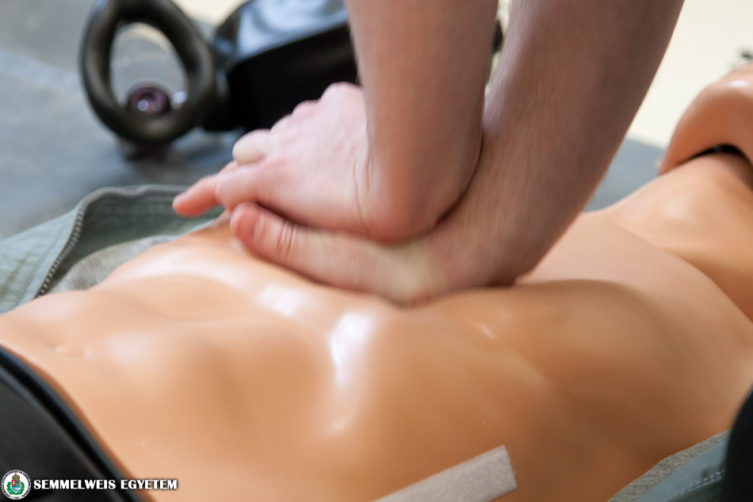 The lectures of the Intensive Care and Emergency Medicine session were mainly about theextensive educational activities at Semmelweis University and their methodological development. Dr. János Gál (Department of Anaesthesiology and Intensive Therapy) said that the department plays a key role in public basic CPR education, undergraduate medical education and the training of other professions. There is a simulation center where case-based exercises, and exercises on high-fidelity simulation dolls, take place. The second lecture was held by Dr. Péter Kanizsai (University of Pécs) on the development and future of intensive care. Dr. Szabolcs Gaál, Deputy Head of Semmelweis University’s Department of Emergency Care presented their educational activities emphasizing the importance of strengthening teamwork and the use of appropriate communication tools. A Semmelweis Egyetemen zajló BLS oktatásról beszélt dr. Hauser Balázs (Department of Anaesthesiology and Intensive Therapy) spoke about CPR education at the university mentioning that all students at the university receive basic CPR education from the first year on.
The lectures of the Intensive Care and Emergency Medicine session were mainly about theextensive educational activities at Semmelweis University and their methodological development. Dr. János Gál (Department of Anaesthesiology and Intensive Therapy) said that the department plays a key role in public basic CPR education, undergraduate medical education and the training of other professions. There is a simulation center where case-based exercises, and exercises on high-fidelity simulation dolls, take place. The second lecture was held by Dr. Péter Kanizsai (University of Pécs) on the development and future of intensive care. Dr. Szabolcs Gaál, Deputy Head of Semmelweis University’s Department of Emergency Care presented their educational activities emphasizing the importance of strengthening teamwork and the use of appropriate communication tools. A Semmelweis Egyetemen zajló BLS oktatásról beszélt dr. Hauser Balázs (Department of Anaesthesiology and Intensive Therapy) spoke about CPR education at the university mentioning that all students at the university receive basic CPR education from the first year on.
The session on Gynaecology was opened by the lecture of Dr. Nándor Ács (Department of Obstetrics and Gynaecology), giving a detailed overview of the developments and challenges of gynaecology care in Hungary. Dr. János Urbancsek (Department of Obstetrics and Gynaecology) spoke about the development and improvement of assisted reproduction. The presentation of Dr. Lintner Balázs (Department of Obstetrics and Gynaecology) explained the role of sentinel lymph nodes in endometrial cancer, illustrated with surgical recordings. The session was closed by the presentation of Dr. Marcell Szász (Department of Internal Medicine and Oncology) on the immunological properties of ovarian cancer.
Dr. Anna Végh
Interviews: Tamás Deme
Featured image and illustrations: Attila Kovács – Semmelweis University
Translation: Ágnes Raubinek
